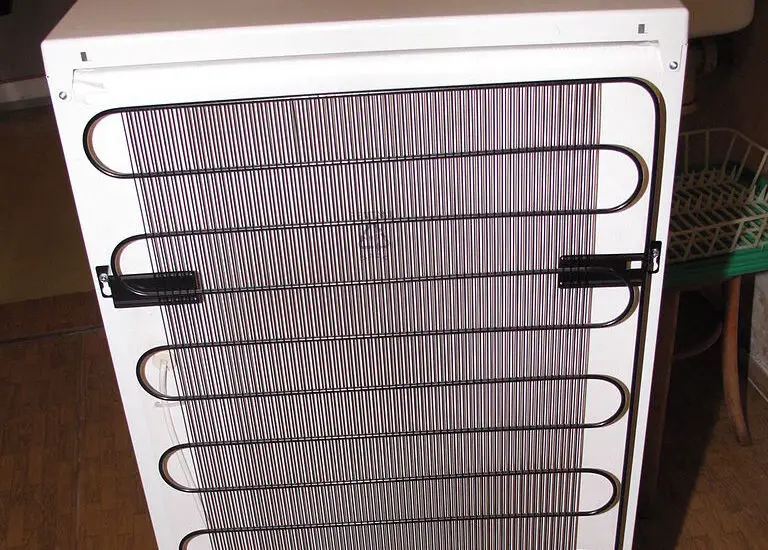Every time you reach for a cold beverage from your fridge, do you ever pause and think about how it all works? The condenser in refrigeration system, that’s what! Here, we’re shedding light on what a condenser does in a refrigerator and the different types of condensers in refrigeration systems.

Table of Contents
Understanding the Role of a Condenser in Refrigeration Systems
When it comes to cooling down your food, the condenser’s the superstar in your fridge. Acting like a heat ninja, it skillfully expels the unwanted warmth from inside, making sure your perishables stay, well, unperished. But how does it pull off this feat? Let’s demystify this.
The Function of a Condenser
It’s simple really. The condenser’s job is to turn gas into a liquid. You might be thinking, so what? Well, this process is crucial for removing heat from your fridge. It’s all about a change of state. By transforming the refrigerant from gas to liquid, the condenser releases the heat outside, keeping your food items cold inside.
Importance of the Condenser in a Refrigerator
So, why should you care about your fridge’s condenser? It’s pretty important. Imagine a hot summer day with no air conditioning. Unpleasant, right? That’s exactly what would happen inside your fridge if the condenser stopped working properly.
Components of a Condenser in Refrigeration System
Ever wondered how the condenser in your fridge does its cool job? It’s got a whole team of components at its disposal. Each part works together, forming a cohesive unit that keeps your food fresh and your drinks chilled. It’s time we got up close and personal with these key pieces of the condenser puzzle.
Construction of a Condenser
It’s fascinating how simple components can come together to form a complex machine like a condenser. Essentially, the condenser is constructed from three key components: the condenser coils, a compressor, and a fan.
The compressor initiates the refrigeration cycle by compressing the refrigerant gas. This gas then moves through the condenser coils where it is cooled down. The fan aids this cooling process by blowing ambient air across the coils, accelerating the dissipation of heat.
The Condenser Coil
Imagine a twisted path, that’s the condenser coil for you. It’s a series of pipes with a very significant role in the refrigeration cycle. The coil acts as a heat exchanger, letting the hot refrigerant gas release its heat to the surroundings as it travels through. As the gas cools, it condenses back into a liquid form, ready for another round in the refrigeration cycle. In short, the condenser coil is the battleground where heat is defeated, and cool is triumphed.
Check out these other related articles…
How to Fix Condenser Fan Motor on Fridge: In Easy Steps
Condenser Fan Not Spinning: 6 Proven Solutions
Refrigerator Condenser Fan Starts and Stops: 4 Easy Fixes
Running AC Without Condenser Fan: Pitfalls & Precautions
Condenser Fan Not Running: 4 Proven Solutions
Types of Condenser in Refrigeration Systems
Just like ice cream, condensers come in different flavors. They all serve the same purpose – to keep your fridge cool – but they do so in slightly different ways. From air-cooled to water-cooled and even hybrid variants, each type has its own unique set of strengths and quirks. Let’s meet the members of this cool club.
Air-Cooled Condensers
Now, let’s get to know air-cooled condensers. As the name implies, these types of condensers use air as their cooling medium.
The hot refrigerant gas passes through the condenser coil and comes into contact with cooler ambient air, courtesy of a fan. As the air whisks away the heat, the gas cools down, condenses back to a liquid, and is sent back into the fridge to continue the cooling process.
These are commonly found in residential and small commercial refrigeration systems.
Pros and Cons of Air-Cooled Condensers
They’re pretty efficient, but they have their downsides. For one, they depend on the surrounding air temperature. Too hot, and they struggle to cool the refrigerant effectively.
Water-Cooled Condensers
On the other hand, water-cooled condensers rely on water for cooling. In this case, water is circulated around or through the condenser coil, efficiently absorbing the heat from the refrigerant gas and cooling it down.
It’s a bit like running cold water over a hot pan to cool it down. These condensers are usually employed in larger refrigeration systems where the surrounding air temperature might be too high for effective air cooling.
Pros and Cons of Water-Cooled Condensers
They can be more efficient than their air-cooled counterparts, but they also require a constant water source. This can make them less practical in certain settings.
Evaporative Condensers
Last but not least, we have evaporative condensers, the hybrid models of the condenser world. These clever devices combine the best of both worlds, utilizing both air and water to cool the refrigerant gas.
In an evaporative condenser, the hot refrigerant gas is cooled by a water mist while a fan simultaneously circulates air over the coil, helping to evaporate the water and carry away the heat. This dual cooling action makes them very efficient, although a little more complex in their design and operation.
Pros and Cons of Evaporative Condensers
They can be extremely efficient, but they also require a bit more maintenance than the other types.